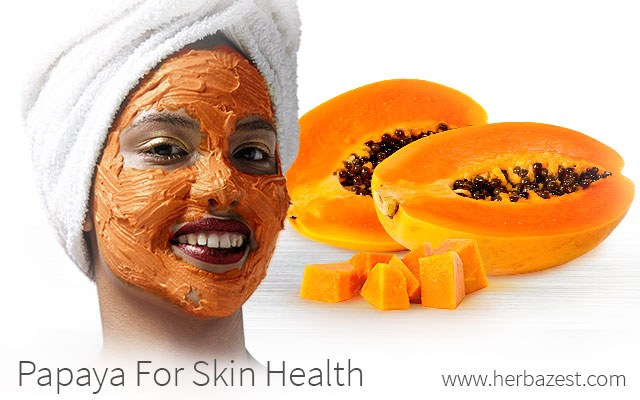Among its many purported health benefits, the tropical papaya fruit has been praised for its healing and soothing properties for the skin. The nutritional value of papaya not only includes high levels of carotenes and essential vitamins, but also an enzyme called papain, which aids digestion and serves as a main ingredient in various commercial products intended to cleanse, smooth, and rejuvenate the skin.
Through several bioactive compounds, the antioxidant benefits of papaya promote healthy, youthful skin.
Skin Problems: Causes and Triggers
The most common skin problems include sores, scratches, swelling, redness, burning, and itching. Though the process of normal aging plays a huge role in lowering the skin's natural ability to heal itself, a number of other factors may also be responsible.
Physiological causes, such as hormonal changes (e.g., pregnancy, puberty, menopause), poor nutrition, infections, allergies, and poor digestion can have a negative effect on the appearance of the skin.
On the other hand, environmental causes - such an excessive exposure to sunlight or heat, cold temperatures, wind, and pollution - can seriously harm the skin and even lead to conditions related to free radical damage.
Additionally, some lifestyle choices - such as an intense exercise routine and a stressful job - can generate changes in the natural appearance of the skin. Other triggers for dermatological problems include increased use of alcohol or tobacco, certain medications, spicy foods, physical injuries, and cosmetics.
How to Use Papaya for Skin Health
While commercial products are widely available, papaya benefits for skin can be reaped through easy-to-make home preparations. They are centered on the use of different parts of the papaya tree, such as the papaya leaf, fruit, and sap.
Papaya facial scrub. This papaya-based exfoliant gently lifts away dullness and restores radiance to the surface of the skin. Apply a mixture of two tablespoons of brown sugar, half a cup of papaya puree, and one tablespoon of extra virgin coconut oil, gently scrubbing away the dead skin to reveal a brighter, more even complexion.
Papaya mask. Combine three tablespoons of honey with two teaspoons of organic papaya powder for a gentle, restorative skin treatment. Apply to the face and neck, avoiding contact with the eyes. After 10 minutes, rinse with warm water.
Papaya compress. For this preparation, the papaya skin and leaves are wrapped in a light gauze and submerged in boiling water for several minutes. The resulting compress is applied to the affected areas of the skin either warm or fully chilled.
The Effects of Papaya on Skin Health
The uses of papaya for skin health are numerous, and there is a thriving market for beauty products that provide papaya anti aging, whitening, and moisturizing properties of the fruit. A natural anti-inflammatory, antibacterial, and antioxidant, papaya promotes wound healing and cellular regeneration after trauma has been inflicted on the skin.
Papain, an enzyme found in the sap of the unripe, green papaya, has been implicated in many of its medicinal actions. The use of papain for skin whitening and exfoliation, as an active ingredient in papaya beauty products is fairly common. The benefits of papain enzyme for skin include the ability of removing superficial layers of dead skin without causing damage to the new, healthy tissue.
Meanwhile, papaya's skin-supporting carotenoids possess powerful phytoprotective properties that prevent sun damage from UV rays.
Papaya vs. Other Herbs for Skin Health
Because papayas are not so widely available in some areas, substituting them with other protective herbs may be necessary. While papain benefits skin by removing superficial layers of dead tissue, as well as by reducing the appearance of dark spots, blemishes, and wrinkles, bromelain, which is an enzyme of pineapple, similarly acts as a natural skin exfoliant and may be used in place of papaya for facial rejuvenation.
Some studies have linked the presence of healthy dietary fats with enhanced elasticity of the skin. The UV protective, antioxidant, and anti-inflammatory actions of avocado make it a good replacement for papaya in skin treatments. It does, however, lack the natural, pleasing aroma and the long shelf life of the papaya fruit.
Given its many healing and protective properties, there's really no better time than the present to start using papaya whitening benefits for skin pigmentation, as well for acne, wrinkles prevention, and much more. For best results, use the skin, pulp, or powder of the papaya fruit in combination with similar herbs.
Sources
- African Journal of Microbiology Research, Studies on the antibacterial activity of root extracts of Carica papaya L., 2007
- Indian Journal of Experimental Biology, Wound healing activity of Carica papaya L. in experimentally induced diabetic rats, 2007
- Living Food for Longer Life, pp. 68 - 71
- Nutrients, The role of phytonutrients in skin health, 2010
- Skin Saver Remedies, pp. 32 - 33
- The Encyclopedia of Skin and Skin Disorders, pp. 313 - 323
- Journal of Ethnopharmacology, Wound healing properties of Carica papaya latex: in vivo evaluation in mice burn model, 2009




